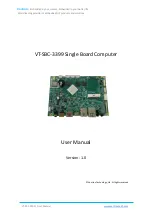
COMe-mEL10 - User Guide Rev. 1.1
// 21
2.3.5.
Graphics (LVDS or eDP, and DP++)
The COMe-mEL10 supports up to two simultaneous displays on the Digital Display Interface (DDI), where DDIO (port A)
is LVDS by default with the option to overlay to eDP requiring a hardware assembly and DDI1 (port B) supports DP++.
The following table lists the display features.
DDI
Display Interface
Description
Max. Resolution
DDI0 (port A) LVDS (default)
Single channel 24-bit color (1 pixel per clock)
1920 x 1200 @ 60Hz
eDP (option)
eDP overlay option requires hardware assembly
4096 x 2160 @ 60Hz
DDI1 (port B)
DP 1.2 V (DP++)
4K resolution with multiple active displays
4096 x 2160 @ 60Hz
Supported Flat panels with Extended Display identification Data (
EDID)/DisplayID.
It is recommended to only use a DP-to-HDMI or DP-to-DVI passive adapter compliant to the
VESA DP Dual-Mode standard. Display detection issues may occur with use of with FET level
shifter adapters for DDC translation.
At 4K resolution, to increase link margin a DP redriver on the carrier is recommended.
2.3.6.
HD Audio
The COMe-mEL10 supports HD audio for up to two external codecs.
Type
Intel® HD Audio
# Audio devices
2x external codec
The HD Audio codec frequency is selected in the BIOS setup: PCH-IO Configuration>
HD Audio Configuration> HD Audio Advanced Configuration> HD Audio Link Frequency>
[6 MHz, 12 MHz, 24 MHZ].
2.3.7.
PCI Express Lanes [0-3]
The COMe-mEL10 supports up to four high-speed PCI Express 3.0 lanes PCIe [0-3], allowing for the connection of up to
four separate external PCIe devices. The default PCIe configuration is (4 x1) with options for (2 x1 + 1 x2), (2 x2) and
(1 x4).
The following table lists the supported PCI Express lane configurations.
COMe Connector HSIO lane
HSIO Port
Supported Lane Configuration
4 x1 (default)
2 x1 + 1 x2
2 x2
1 x4
PCIE_0
2
PCIe #0
x1
x2
x2
x4
PCIE_1
3
PCIe #1
x1
PCIE_2
4
PCIe #2
x1
x1
x2
PCIE_3
5
PCIe #3
x1
x1




































